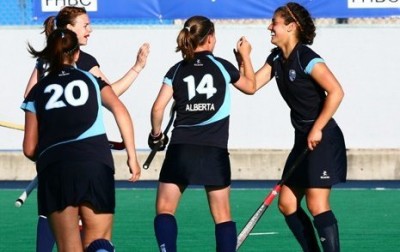
Ages 16-19 +/- yrs
In the Training to Compete stage athletes now have the core skills to strive within a competitive environment. The focus now shifts to consistency in execution of these skills and training under pressure. Athletes begin to specialize in field hockey with sport-specific training sessions 9-12 times per week – including technical, tactical, and physiological components.
The purpose of this stage is to begin to prepare the elite athlete for high performance competition in the clubs, provincial programs, universities, regional centres, and national teams. Many athletes will choose to continue participating in field hockey at a more recreational level thereby entering the Hockey for Life stage. For the high performance athletes, training begins to occur year-round.
The Training to Competition ratio shifts to 40:60 % and competition includes both competition-specific training and actual competitions. Competition should include 1-2 times per week recreationally with two or more times per week focusing on the introduction to elite domestic and international competition within a season of multiple months with adequate periods of rest and recovery in between. Utilize single, double, and triple periodization as the optimal framework of preparation.
Physical
All systems are fully trainable towards the end of the stage. Testing should determine the priorities of training emphases such as aerobic and anaerobic endurance, speed development, strength training, footwork and agility, and positional considerations for fitness and strength training.
Coaches refine routine practices of recovery, regeneration, and nutritional needs. Injury care and prevention are emphasized through a strong core and flexibility program pre-and-post workout / competition.
Technical
Advanced ball and stick skills are performed at speed. This is the critical stage for the development of the High Performance athlete. Specific skills are integrated and high proficiency level for both attacking and defending is expected. Development of consistency under pressure in a variety of situations. Mini-games are important with emphasis on using specific skills with the element of competition.
Athletes have perfected FunStix skills and working on the refinement or perfection of: Lift dribbling, eliminating skills, hitting, flicks, one touch passing, scoops, advanced scoring skills, deflections, steals, shave tackles, and penalty corner skills.
Goaltenders have perfected measuring angles and begin to work towards perfection of feet/pad saves and low clears. Refinement commences on sliding, hand/stick saves, and high clears.
Tactical
Decision-making in game play (eg. focus on ability to read the game) is important in this stage. Athletes focus on the use of space, creating numerical advantage, transition of play in attack and defense, creating or preventing goal scoring opportunities, and defensive and offensive positioning with reference to ball speed and pressure.
Use of press and relevant positioning.
Use and awareness of roles and responsibilities in half court tactical play.
Tactical manoeuvres aimed at very quickly shutting down opposition attacks or counteracting opposition. Not permitting space by close marking. Creating space by off the ball movements.
Individualized specialization of set play pieces and duties on the pitch regardless of position.
Implementing the game plan and dictating the pace of the game.
Mental
Develop competitive attitude and mental skills needed to manage anxiety and perform consistently with an emphasis on personal accountability for performance excellence. Promote on and off-field strategies to maximize teamwork.
Mental capacities: Commitment to training at high intensity, ability to manage activation/arousal level, goal-setting, self-awareness (high level of awareness of factors that maximize and minimize performance), knowledge and use of planning, critical evaluation of training and competition, competitors mindset (confidence, focused, determined), personal responsibility and involvement in decision making, sport-life-balance skills, and on and off-field strategies to maximize teamwork.
Health
It should be considered that some athletes may gain height until 20-21 years old.
Nutrition: Maintain balance of nutrient rich foods, with attention given to calcium and iron, ensure caloric intake meets needs of activity, and hydration.
Strength and Flexibility: Ensure strength and flexibility meets the requirements of the sport, and continue to decrease muscle strength and flexibility imbalances.
Injury Prevention: Continue specific injury prevention programs to decrease risk of repetitive use injury, including core stability, continue at least 6-8 weeks of preseason conditioning prior to intense sport participation, introduce cross training activities for 2-3 aerobic training sessions per week to decrease overload to any one group of tissues, introduce the concept of Integrated Support Team (IST), and ensure all injuries are fully rehabilitated.

